I’ve been testing the Lomi Home Composter from Pela for a few months now. I’ve put the Lomi through our household’s wringer to see what it could handle. I’ve tested every cycle and I’ve run hundreds of cycles at this point.
I was an early supporter of Lomi, purchasing one during their Indiegogo Campaign. This was a product I was really excited about!
For some reason, wires got crossed and the folks at Pela actually sent me another Lomi (free) to test out.
All disclosures aside, I’ll explain my experience with and opinion of the Lomi thus far. If you prefer the short and sweet version, get the TL;DR version right below. Otherwise, we’ll first explain what the Lomi is, how it works, and my experience further.
TL:DR – Lomi Composter Review
What is it? Is it Worth it?
The Lomi Composter is an extremely innovative way to process your household organic waste (food, plant clippings, etc.). I think the Lomi does what it does well! However, I don’t think the Lomi is the best fit for everyone. Personally, I wouldn’t buy the Lomi if I had to do it all over because I already have a composting system that works well for me and meets a greater capacity for my 4 person household.
All that being said, I think the Lomi Composter could be a great fit for a small/individual household that is okay with the upfront higher cost. The Lomi processes food waste cleanly, quickly, and effectively. Lomi lives up to the claims of speed, little/no smell, and little/no mess.
If it was just me or even just my wife and I, while not the cheapest means to get started “composting,” the Lomi could be a perfect solution. There’s little the Lomi can’t process, it’s relatively mess-free, and it’s fun to find ways to use the “dirt” Lomi produces around your home.
Setup costs are high and you’ll continue to need to switch out filter materials and purchase LomiPods on an ongoing basis. The Lomi takes up some space and requires some extra countertop room. If those aren’t dealbreakers for you, you might really enjoy having the Lomi as your food waste solution.
What is Lomi?
The Lomi is a countertop composter designed by Pela to rapidly break down your household organic waste into a ready-to-use nutrient-rich fertilizer. Yes, that’s right, Lomi isn’t creating compost.
The “dirt” Lomi produces (or what they call Lomi Earth) is as they describe more of a fertilizer, or as I’ve thought of it, a soil amendment. This amendment or fertilizer can be added to soil or an existing compost system (more on that later).
You can see some example samples of Lomi “Dirt” below:
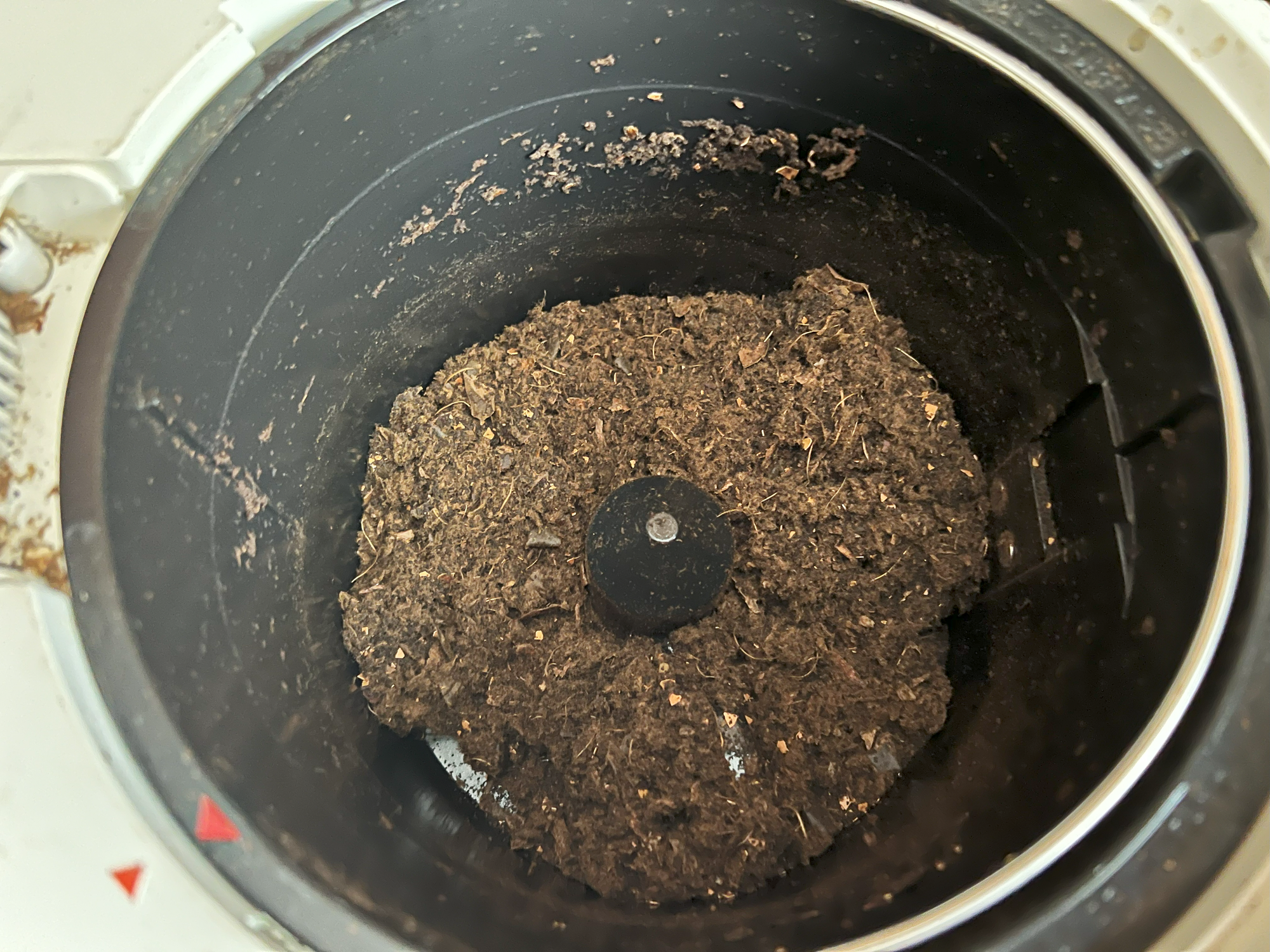
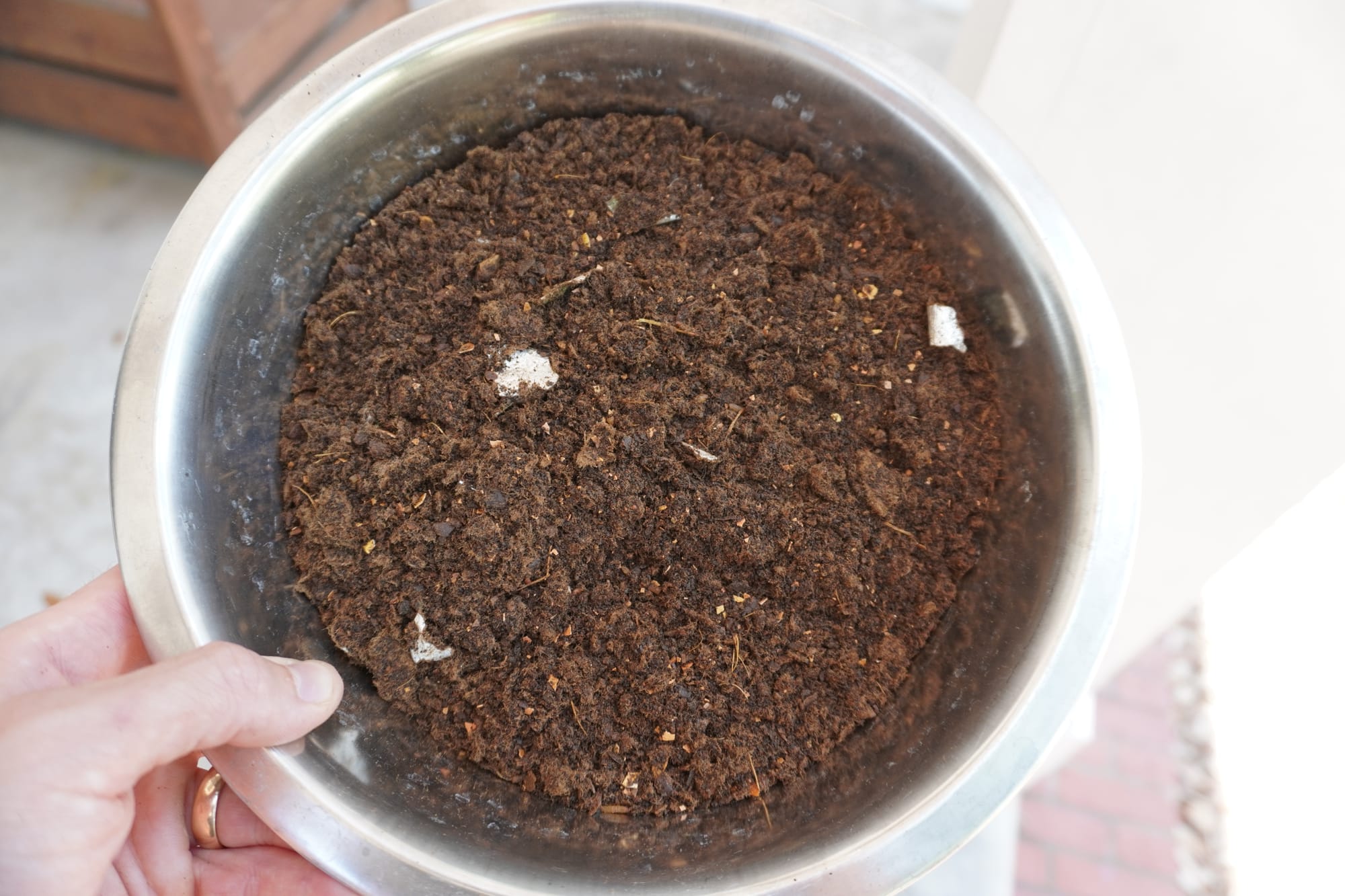
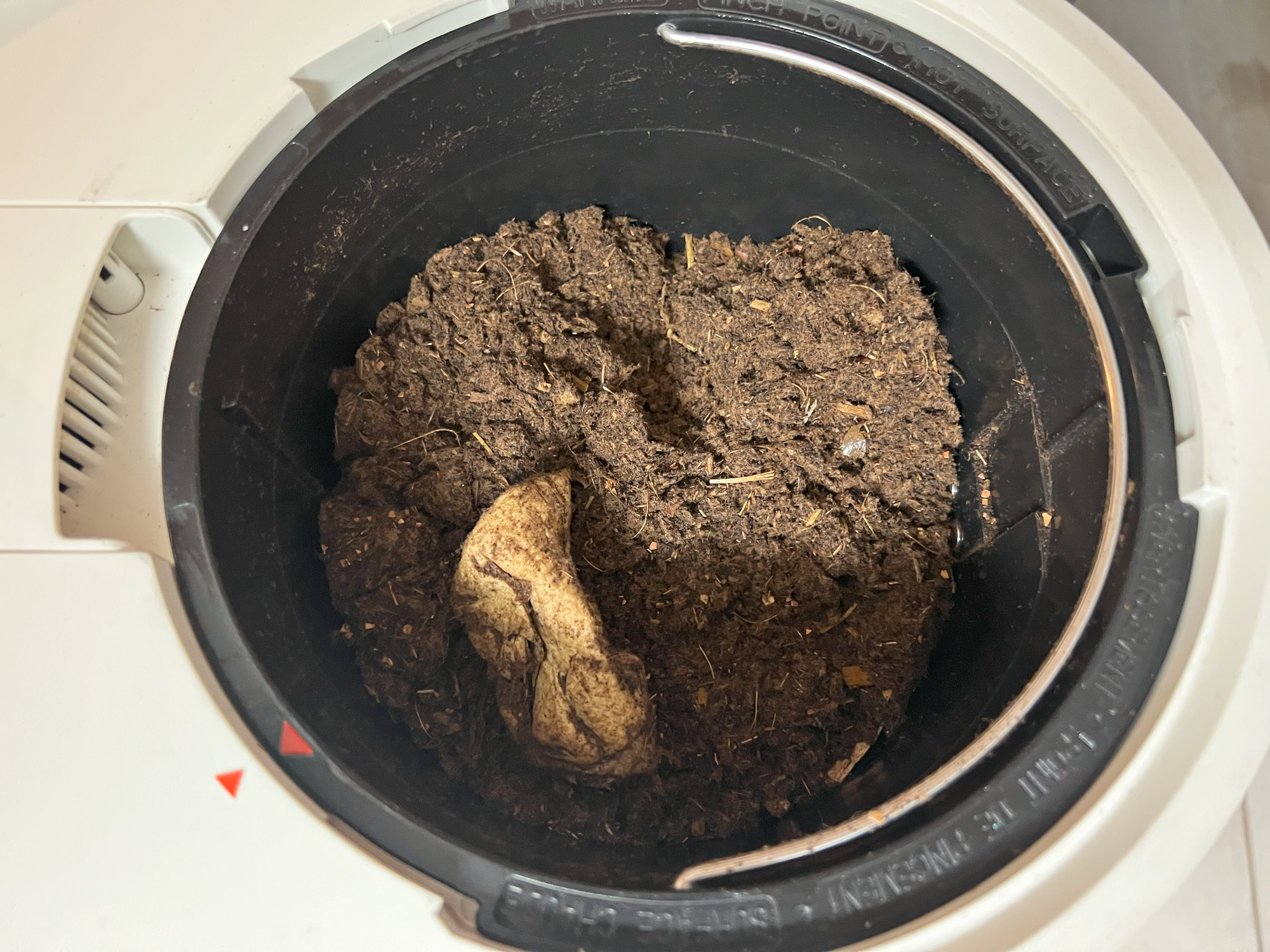
How Big is the Lomi?
The Lomi is almost 20 lbs and about the same size as a toaster oven. It’s a reasonably large appliance.
How Does the Lomi Work?
Using the Lomi is actually really easy. Add your food scraps, house plant trimmings, etc., until you reach the capacity line. For best results, make sure all scraps all well chopped up.
Once you’re there, add in a LomiPod, a splash of water, and choose your cycle (in my experience, mainly Eco-Express).
Here are the Lomi modes to choose from with their designated functions:
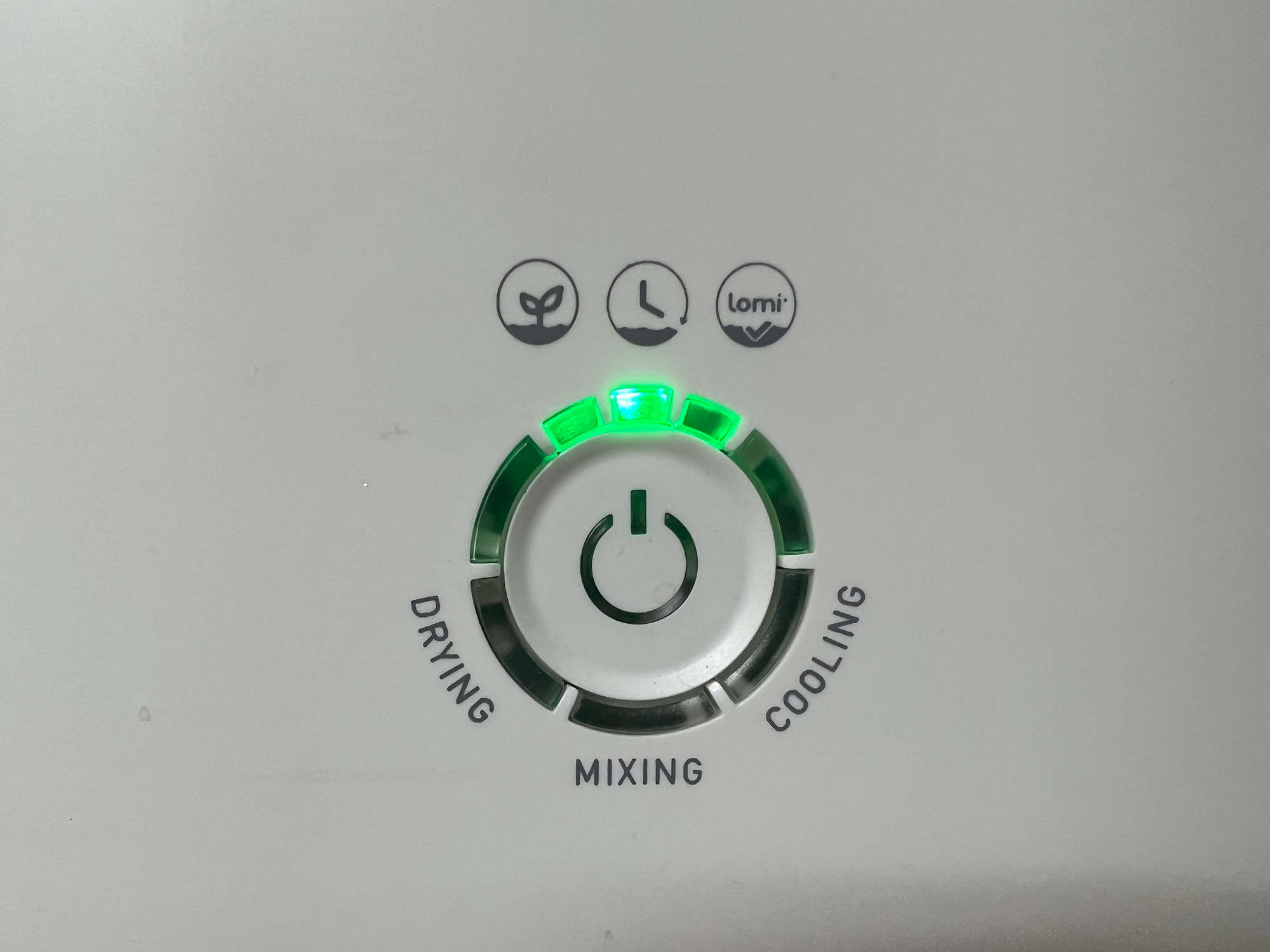
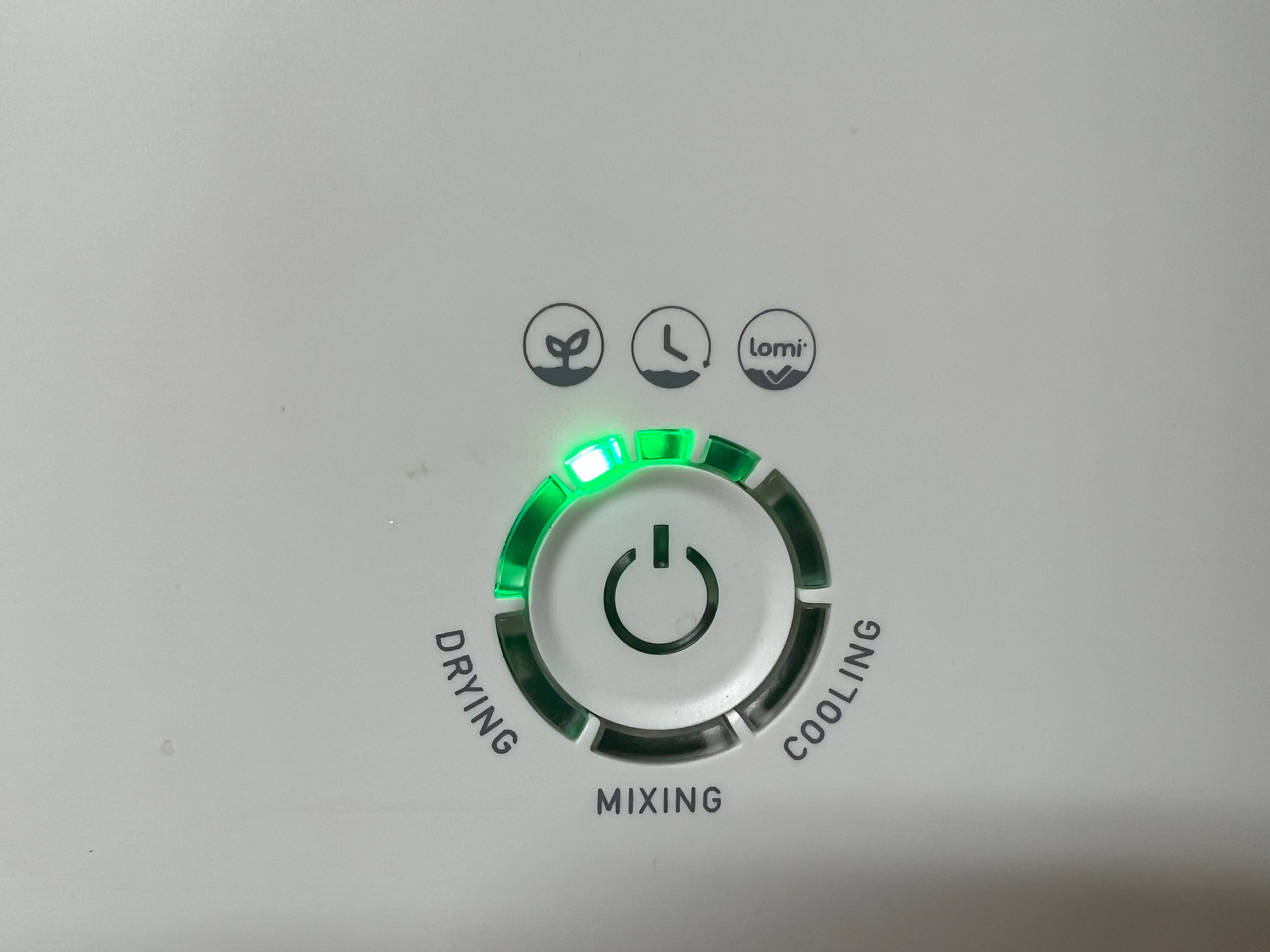
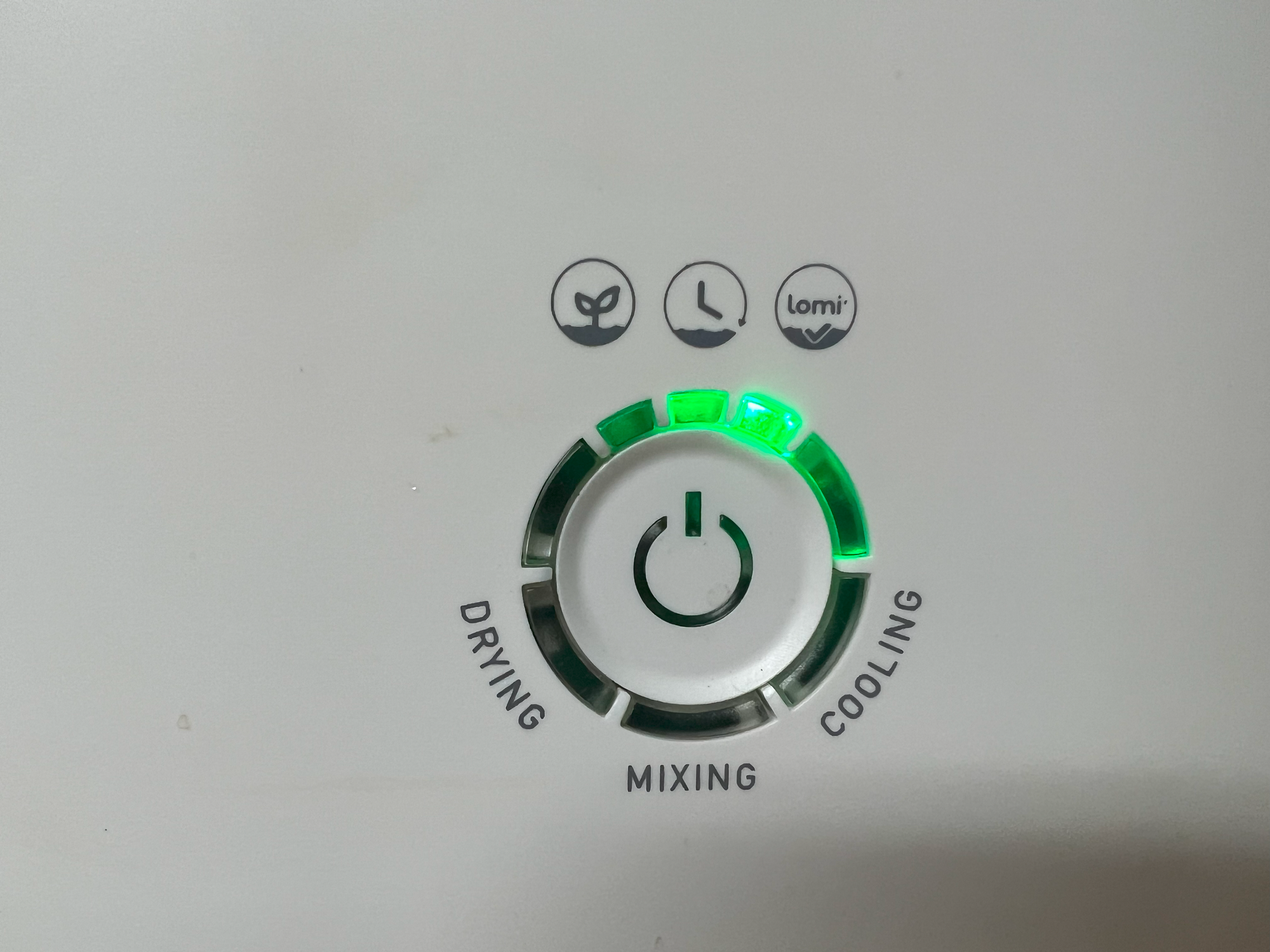
Eco-Express: This mode takes ≈3-5 hours (the shortest time of all modes) and requires the least energy. The Pela folks recommend using what’s produced with this mode with your next Lomi cycle or disposing of this in your green organics bin.
Pela also suggests using this mode for cooked foods or other normal food waste.
(Not recommended to use directly in the garden)
Grow: This mode takes ≈16-20 hours and as recommended by Pela, is meant for only fruit and vegetable waste (not bioplastics or cooked foods).
If I had processed my cooked foods using the Eco-Express mode already, I was fine using my Lomi “Dirt” from that cycle for a future Grow Mode. Grow Mode is meant to run at a lower temperature (most likely why it takes so much longer) so that the greatest amount of beneficial microorganisms can be preserved.
Lomi Dirt produced from Grow Mode can be added directly to the garden!
Lomi Approved: This mode takes ≈5-8 hours and is meant to process Lomi Approved bioplastics (such as the packaging that comes with the Lomi!). They recommend running those Lomi Approved bioplastics with food waste at a 1:10 ratio (1 being the Lomi Approved bioplastics).
In each cycle, the Lomi is accelerating what happens normally in the composting process. The Lomi cycles are heating up your food waste and grinding it into smaller pieces, all things that naturally occur in decomposition, but at a much quicker rate using the Lomi.
They do share much more about what’s happening within the Lomi, here.
👍 Tip
How to get the best Lomi “Dirt?” — The folks at Pela recommend diversity of what you put in your Lomi as the #1 way to get the best Lomi “dirt” out on the other side. As well, they recommend using a LomiPod.
Lomi says that their “Grow” cycle (which takes ≈24 hours to complete) will get you the highest potency* dirt upon completion because the lower temperature Grow cycle will preserve the greatest amount of microorganisms.
What Does/Doesn’t Go in the Lomi
Here’s a list of what all does or doesn’t go in the Lomi (as outlined by the Lomi folks themselves). I’ve highlighted what I’ve verified can be tossed into the Lomi with success:
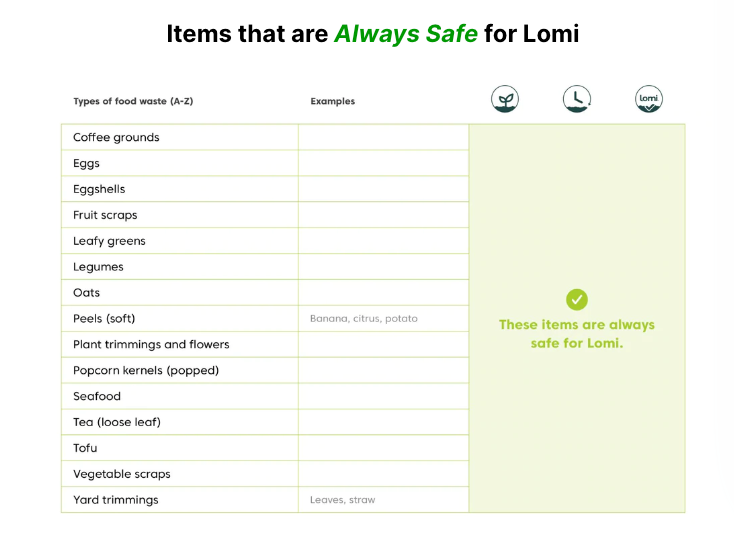
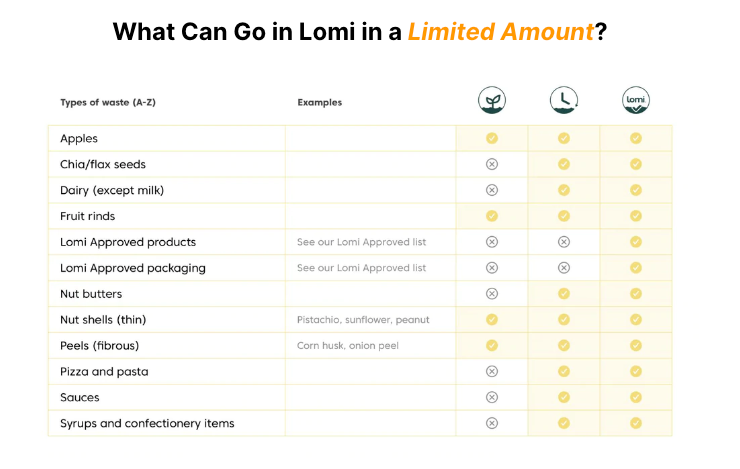
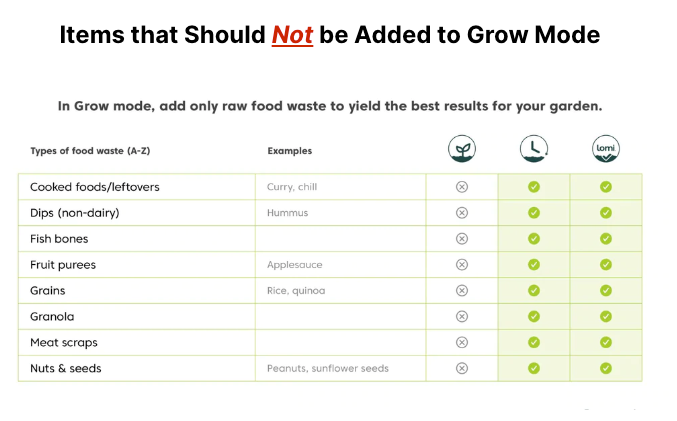
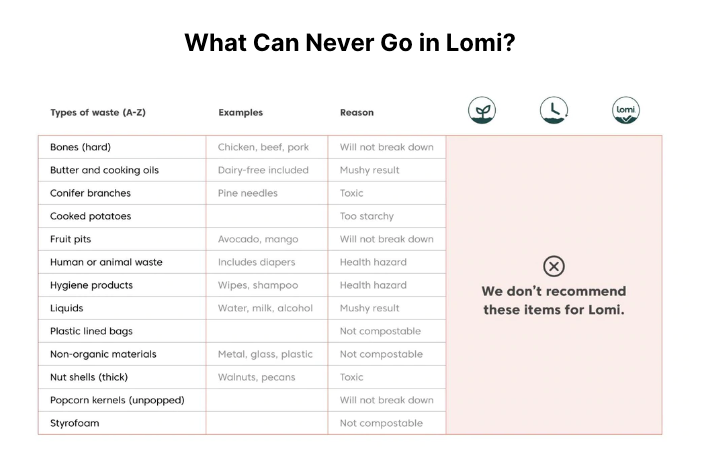
Notes: I will tell you that I have been adding things to my Lomi over the last three months without thinking much about it. I’ve added butter and cooked potatoes to my Lomi in very small amounts and I can’t recall a cycle where those affected the outcomes negatively. I honestly surprised myself when fine-tuning my research for this review!
I likewise wasn’t too considerate of how Limited the “Limited Amounts” of items were that I added into my Lomi. I wanted to test the Lomi for how convenient and easy to use it would be. One of my measures of success for a successful compost system? ➡️ How much do you have to think about it?
And despite what these above charts might suggest (provided by Lomi), I didn’t think too hard about what I was adding to my Lomi (a definite pro for Lomi).
However, for the longevity of your machine, if you do get one, best to follow their advice as much as you can.
My Lomi Experience
➤ Learn more
If video is more your speed, I also break down my experience with the Lomi Composter on my YouTube channel, check it out below.
Testing Time: ≈3 Months
Personally, I’ve found the Lomi to be an incredible machine! It’s no joke. Hit the “Eco-Express” on Lomi (the default setting) after adding in your food scraps and a LomiPod, then roughly four hours later, you have a substance that’s dry, mostly odor-free, and ready to add to your green bin or existing compost system.
I’ve been really impressed with how well Lomi performs and all the different varieties of household organic waste I can put into it. The Lomi has come to be a useful complement to my greater compost system. However, given the size of my household (4) I haven’t found it to hold a high enough capacity to be used completely on its own.
I have inevitably run into the scenario where the Lomi is full but there’s more food waste to add. While testing the Lomi, I’ve still been bokashi composting, so, instead of letting my food waste sit around on the countertop or in the fridge to wait for space in the Lomi to free up, I’ve added excess food waste to that system.
I’ve found Lomi to mostly deliver on its claims of convenience and cleanliness. Anyone who has used a normal compost caddy in their kitchen has run into fruit flies, some gross caddy clean-ups, or folks in their household who don’t want to take out the caddy and are fine letting the food scraps pile up so that the lid doesn’t close fully.
Lomi’s lid is easy to open and seals airtight (although it beeps EVERY TIME) and if you can fit it in on your kitchen countertop, you’ll find little inconvenience to utilizing it.
For my kitchen, though, our countertop space is limited and the Lomi is quite sizeable, so during my testing, I actually ended up relegating the Lomi to the garage on top of the washing machine. Of course, this made it far less convenient to use, but it made the rest of the household happier with me.

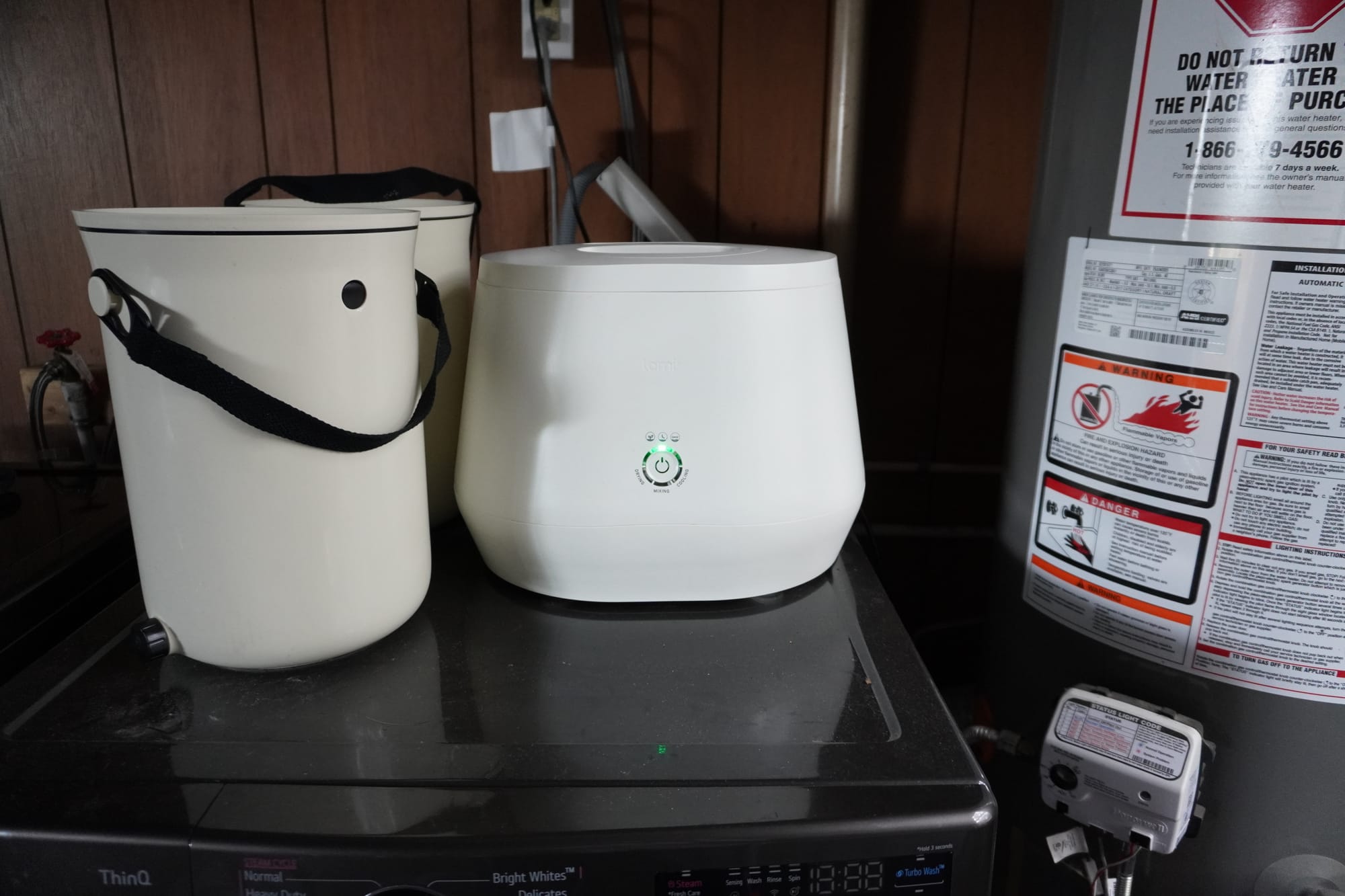
I threw all I could over roughly three months into the Lomi and sure enough, it broke things down quite efficiently and effectively. Anytime there was a “failure,” it was because I added too much of a single thing (like an entire egg carton for example) or if I didn’t break that thing down well enough (especially if it was harder, e.g. watermelon rinds, broccoli stems, etc.).
Lomi cycles were (mostly) quiet, depending on what I had in the Lomi. But, there was one night where the Lomi ran and my wife and I were convinced there was a dying cat somewhere outside our house. The Pela folks claim the Lomi is quieter or on par with the average dishwasher, which I’d say is true. I mostly ran the Lomi overnight and when I did, it was rare that we heard anything.
Any changes in energy usage were negligible, Lomi offers a useful chart and suggests that it would cost me in Texas $.07 per Lomi cycle on average. I ran cycles nearly every day, and so, with a little math (using Lomi’s figures), using the Lomi could’ve cost me ≈$1.60 – $1.75 per month.
I routinely ran two Eco-Express cycles (adding in food scraps each time) then finished with a Grow Mode cycle. With my finished “dirt,” I’d add it to my existing compost bin or add it directly into soil I’m using for a lawn revitalization project.
Once my LomiPods run out and I need more filtering activated charcoal, I don’t know if I’ll re-up. Mostly, because I have an existing composting system that I like (bokashi composting) and I see the Lomi as a “fun” addition to my composting system now, but not essential. As well, I don’t think the Lomi can conveniently keep up with the food waste a household of 4 creates.
MY FOOD WASTE COMPOSTING SYSTEM (CURRENTLY)
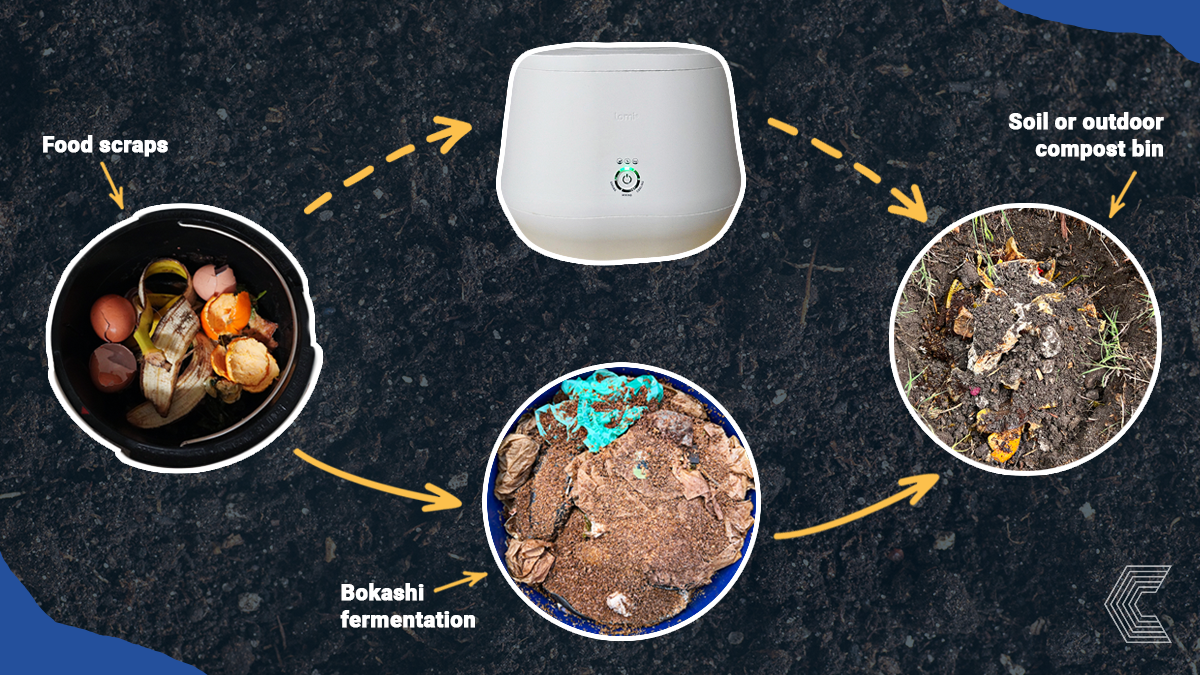
All this being said, I can see how the Lomi would be great for some people. Let me summarize some of my pros and cons to the Lomi Composter, going over each in a little more detail, and then outline specifically who I think the Lomi would be best suited for.
Lomi Composter: Pros & Cons
Pros
No Mess!
If the mess of keeping your food scraps in a countertop compost caddy is a big turn-off for you with composting, then Lomi really solves this issue! The airtight seal makes the process odorless (except for when you open the lid) and having all the food scraps broken down inside the Lomi makes for no mess after a Lomi cycle is finished.
Convenient
Despite being messy, having a countertop compost caddy to throw your scraps in is quite convenient. It’s not convenient to unload your caddy (depending on the situation), but adding the one-off banana peel or coffe grounds is quick and easy when all you have to do is pull off the lid.
The Lomi offers similar convenience. After some use, screwing and unscrewing the Lomi lid is a breeze and nothing that deters you from adding anything new.
The *beep* every time you open the lid is one thing I hope they change in the future, however.
Results are Usuable, Quick!
Comparing how the Lomi processes food scraps to how it’s done in other composting methods, you are getting to use that valuable organic matter in your garden FAST!
For example, if you run an Eco-Express cycle once a day for two days, then fill up the Lomi again and run your Grow cycle, you are getting a usable soil amendment in just about 3-4 days.
With Bokashi composting (the other fastest method I know of), you are getting a soil amendment in about 14-21 days after you fill your bin, then usable compost roughly 4-6 weeks after that!
Cons
Lomi is Big!
The Lomi is just about 20 pounds. It’s the heaviest countertop appliance I own! It also takes up a lot of countertop space. Frankly, I disagree with their sales copy, “Small enough to put away…” Not always having Lomi plugged in and accessible sort of negates some of its utility, and as mentioned, it’s pretty big.
For much of my testing, my Lomi sat on a countertop in our kitchen. Within a couple weeks, as I mentioned earlier, I had to relegate the Lomi to the garage on top of our washing machine. Granted, our kitchen designed in 1954 doesn’t have the most “open” plan, but even still after enough time, I couldn’t justify the Lomi taking up the space it did in our kitchen.
Lomi Has a Small Capacity
Including myself, we have a household of four. It’s not uncommon for Lomi to fill up for us within a single day. Maybe we create a lot of food waste? Regardless, as is, Lomi couldn’t serve as our only means to process our food waste.
Once it’s filled, you can’t access Lomi for as many hours as the cycle you choose to run. For the most part, that means if we want to always be able to use Lomi, we can only use the Eco-Express Mode. Multiple times when testing the Grow mode, I had to make sure our Organko Bokashi bin was available.
There are workarounds, of course, like keeping food scraps in a bag in the fridge until Lomi finishes its cycle, but, I personally prefer to set up these systems in the most convenient way possible.
Sometimes…my greater household won’t comply… 😒
Lomi is Expensive
Lomi is a high-priced product, and not just one time either. I originally was an Indiegogo backer for the Lomi and then Pela sent me one to test out (I’ve been connected with these folks for a while). I believe with the Indiegogo I was able to purchase the Lomi was a little less than it’s listed now, which I see can be ≈$400 – ≈$500 depending on which package you choose and if Pela is running any promotions (FYI: they run TONS).
At the time I’m writing this review, there is a “Spring Garden Flash Sale” offering 20% savings. To be clear, I don’t love promotions like this, especially at the frequency I’ve known Pela/Lomi to run them. What’s actually “full” price?
I get wary of companies running constant promotions and discounts…am I ever really getting the best deal? Should I really “buy now” to get these savings? Anyways…that’s a tangent for elsewhere (see: Ethical Marketing).
Also, to use the Lomi you need filters and their Compost Accelerator pods. At their best deal (currently) you can get 180 cycles worth of LomiPods and Activated Charcoal to filter for $155.
That’s about $0.86 per cycle (excluding the energy costs mentioned earlier). If you run cycles 75% of days (I did more than that for my testing), that’s 274 cycles in a single year. That would mean roughly ≈$235.64 for LomiPods and Activated Charcoal.
So, in the first year with Lomi, you’ll spend over $500, easily. A bit high upfront.
Every year after, maybe ≈$235 (more or less depending on how many cycles you run). Or, roughly ≈$20 per month. Not terrible, but not nothing.
No End of Life Program (For Now)
I couldn’t see it easily listed on their site or FAQs, so I reached out to support to ask about the lifespan for Lomi and what happens afterward.
Support suggested that the Lomi should run for at least 5 years (which seems short). And after that, it’s not clear what you do with your non-operational Lomi (the trash?).
However, let’s *hope* that if you bought a Lomi today, 5 years from now that Pela has figured out a recycling or refurbishment program for Lomi. Surely far less complicated, but they have determined an end-of-life plan for their Pela Cases. I’d expect they do the same here.
Is the Lomi Composter Worth It?
So, all this taken together — do I believe the Lomi Composter is worth it?
I’d say for some people, no, and for others, yes.
I think the Lomi Composter is best for someone living in a small space (apartment dweller) or a small household. As well, I could see the Lomi being really valuable for someone in colder climates who has limited composting options or no city-wide green bin collection during the winter months.
You could use the Lomi all winter either using it for houseplants or collecting the Lomi dirt in a bucket mixed with some soil. Spring comes and it’s ready for your garden.
I’d also add, if getting the Lomi is the difference between you processing your food scraps the most sustainable way, or just tossing them in the garbage, get the Lomi!
Composting is important. So, all this is about finding the right system for you.
If Annie and I were still living in an apartment as we were in Boston, I could see the Lomi being really valuable (despite our lack of square footage). Now in a much larger space with an established composting system I like, the Lomi makes less sense.
Either way, I still would have to think twice about the cost. I do hope for the sake of their impact, Pela is able to find a way to make the Lomi and all the add-ons much more affordable in the coming years.
Not to mention increase the projected lifespan of these products and determine their end-of-life.
If you end up getting the Lomi or have one already, be sure to let me know what you think with a comment below.
And, if you are curious as to how we evaluate products (the process behind this post), I recommend checking out our complete guide on What is a Sustainable Product?
